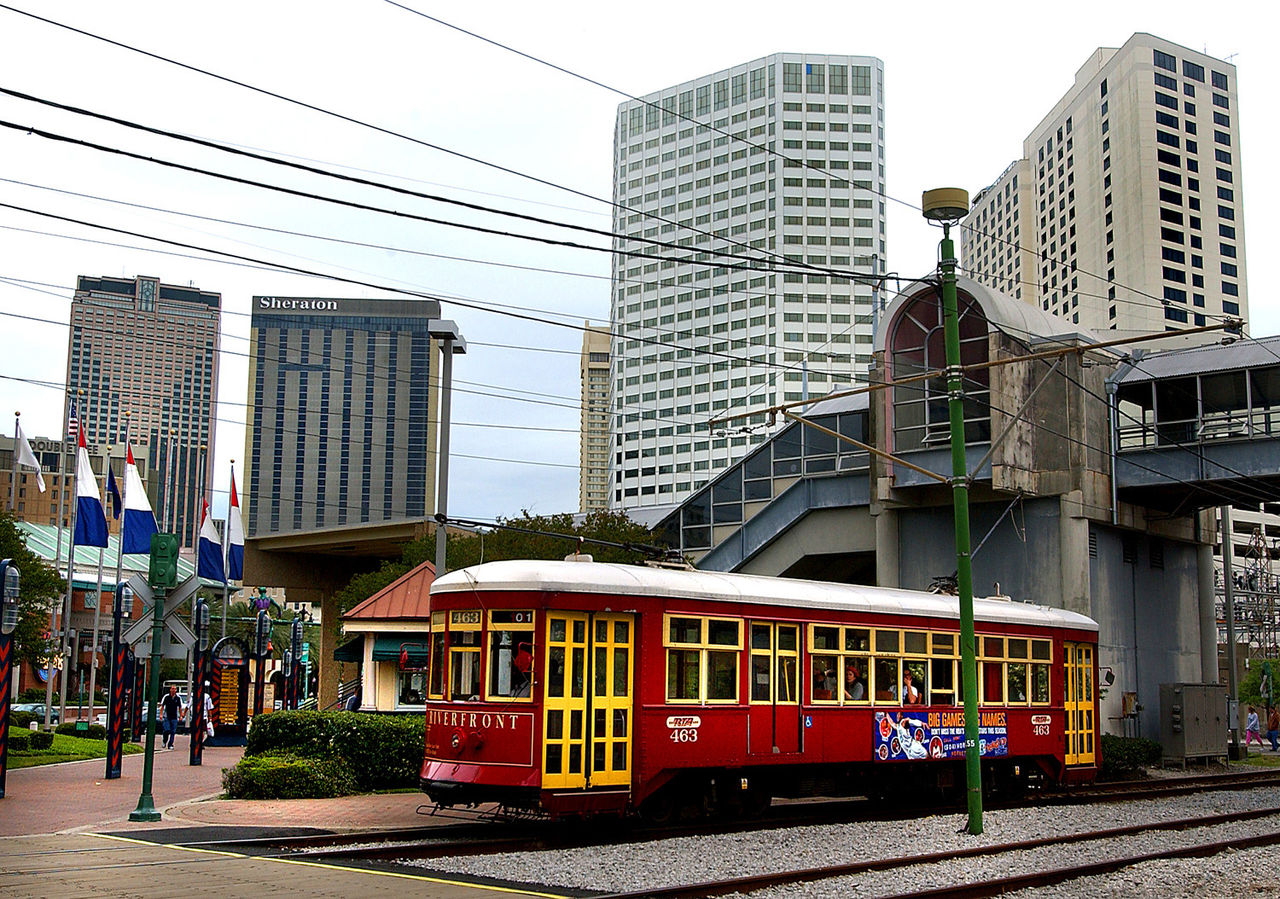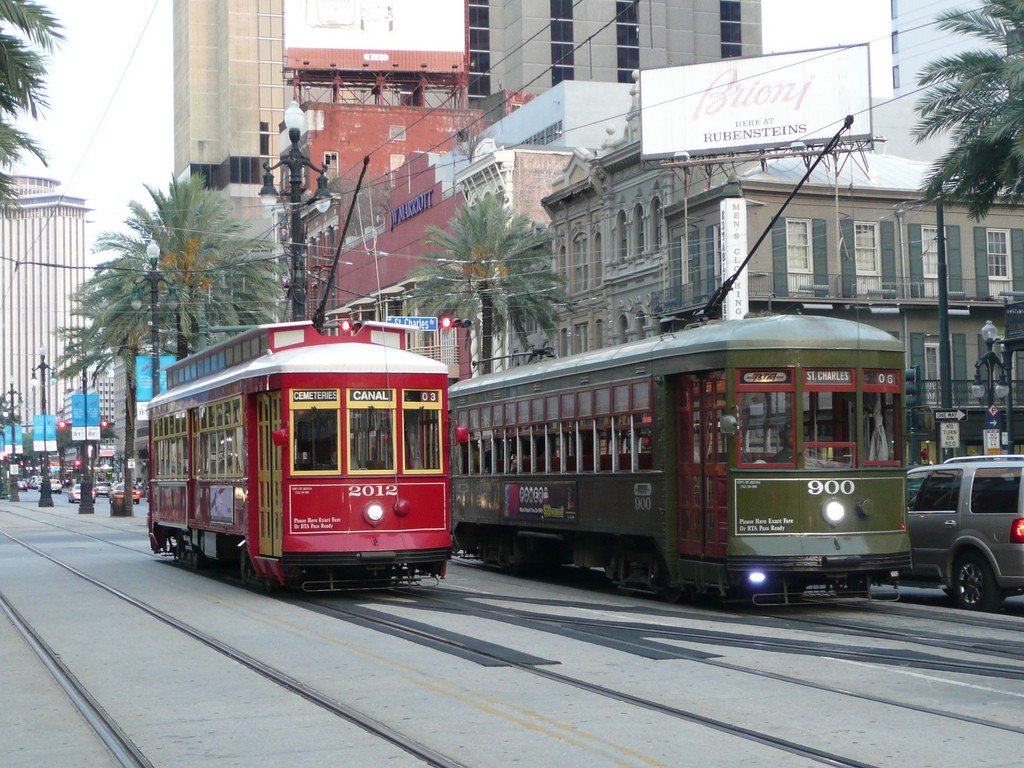-----
 |
| RTA (Ex-NOPSI) 904 outside Loyola University on the St. Charles Streetcar. (Loyola University New Orleans) |
 |
| New Orleans RTA Logo (NORTA) |
The RTA began in 1979 when the Louisiana state legislature created the agency with the intent of replacing private mass transit operation within the city of New Orleans. At this time, the St. Charles Avenue Streetcar (in continuous operation since 1835, electrified since 1893) was run by the New Orleans Public Services Incorporated (NOPSI) and was the only streetcar left in operation as NOPSI had converted all the other streetcars to buses in the 1960s. The St. Charles streetcar itself was declared a National Historic Place in 1973 by avid preservationists, securing its future but still under control of a private organization. As NOPSI was looking to divest its transit holdings and focus primarily on electric and gas utilities (as Entergy New Orleans), operation of the St. Charles streetcar was transferred to RTA in 1983.
 |
| Ex-Melbourne W2 452 in 1988, during the first year of Riverfront Operations (GFDL) |
Under new ownership, RTA started refurbishing 2 previously-retired Perley cars for the line's first major expansion since the Canal Streetcar closed in 1964. With two Melbourne W2-types joining the fleet as ADA-compliant cars, the Riverfront Line opened on August 14, 1988, as not only the first line to open under the RTA, but also the first "new" New Orleans streetcar route to open since 1926 that wasn't just a line expansion. The line initially opened as a standard gauge single-track line between the French Market and West among the Mississippi River to John Churchill Chase via Canal Street, but an explosion in popularity forced a major expansion in 1990 that added two-tracked the line and one more Perley and Melbourne W2 to the fleet.
Oh, and they operate buses too. I forgot.
-----
After a solid decade in service, RTA came down with a plan to expand the Riverfront line. To do this they planned a connecting track up Canal Street to Carondelet/Bourbon to interchange with the St. Charles streetcar. However, the Riverfront was still standard gauge at this time, so the line would have to be regauged to 5'2.5" Pennsylvania Trolley Gauge (which the St. Charles streetcar ran on). At the same time, RTA wanted more wheelchair access on the Riverfront Line (which the St. Charles couldn't do as a national historic place) so they decided to make replicas of the Perleys with modernised equipment with the help from Brookville in 1997.
 |
| Replica Perley 463 at Canal Street and Riverfront, gussied up in a fine red and yellow livery. Looks familiar... (US Department of Housing and Urban Development) |
Between Brookville and the Carrollton Shops, the first modernised Perley was outshopped in 1997 using the body of the former Perley No. 957, now numbered 457. This car had a wheelchair access door cut into its side and had PCC trucks and controls installed from retired Philadelphia cars. 457 served as the pattern for six other replica cars numbered 458-463, which all received new trucks and controls from CKD Tatra. These cars went into operation on December 13, 1997, displacing the Perleys and W2s. Two Perleys were retained at Carrollton while the third was sold to San Francisco MUNI, and the W2s went go to the Memphis Area Transit Authority. Brookville would later provide the 2000-streetcars for the Canal Streetcar line, these sporting odd clerestory roofs but otherwise built to the same Perley pattern as the 457-series.
 |
| Brookville Replica Perley car No. 2003 on Canal Street on April 18, 2014. The clerestory roof hides air circulators and an air conditioning system, really helpful for those swampy summers. (Didier Moise) |
 |
| A New Orleans color-coded RTA map with the original alignment for the Loyola-UPT streetcar. (NORTA) |
The second line to open under the RTA wasn't so much rebuilt as it did "come out of hiatus." The Canal Streetcar originally closed in 1964 under NOPSI and was served by buses using its central median alignment through New Orleans' Central Business District. The cars serving these lines were deemed surplus to requirements and scrapped or donated, while the 35 reserved for the St. Charles line were spared. In 2000, RTA announced that it would bring back the Canal Street line and the first branch out, running straight south from Cemeteries, were rebuilt that same year. To maximize rider accessibility, The Canal Streetcar was split into two branches, one running to Cemeteries and the other to North Carrollton Avenue and the Museum of Art, a first for the system. The line officially opened on April 18, 2004.
Like a lot of the delta, Hurricane Katrina hit the RTA hard especially when the levees broke and the city flooded. Miraculously, the 35 original Perley cars emerged unscathed while almost all of the replica Perleys of the Canal and Riverfront line were heavily damaged. The Carrollton Shops would spend three years repairing the entire replica fleet with Brookville spares while service along what could be salvaged from Canal Street was operated by the St. Charles Perleys. By 2008, the areas rendered uninhabitable along Canal Street saw resumed service and the replica cars returned to operation one year later.
![Hurricane Katrina] New Orleans, LA, 2-4-06 -- New Orleans Transit ...](https://cdn10.picryl.com/photo/2006/02/04/hurricane-katrina-new-orleans-la-2-4-06-new-orleans-transit-workers-clear-streetcar-0680dd-1600.jpg) |
| NORTA No. 968 assists with track repairs in February 2006 following Hurricane Katrina. The trucks are due to the lack of overhead wiring. (Marvin Nauman and FEMA) |
 |
| Mayor Mitch Landrieu celebrates with the St. Augustine Purple Knights during the opening of the Loyola Streetcar on January 28, 2013. (US Department of Transportation) |
The last line to open in recent years was the Rampart-St. Claude Line, originally known as the Loyola Streetcar. This line was not a historic reconstruction like Canal Street nor a tourist line like the Riverfront car, but instead solved a problem staring the RTA in the face for quite a while: connecting the Union Passenger Terminal (UPT) to the streetcar system. The whole route ran between the UPT through Loyola Street and down Canal to Harrah's Casino, sometimes connecting through the Riverfront to French Market. The line would be cut back and rerouted as the Rampart-St. Claude line connecting through to Elysian Fields. Following the Hard Rock Hotel Collapse, the Rampart-St. Claude folded into the Canal Cemeteries line, while the Canal North Carrollton/Museum line runs south to the Riverfront Streetcar.
Today, the RTA maintains 286 streetcar stops over 5 lines spanning 22.3 miles through the center of the Crescent City. The trolleys maintain an identity as distinct as cajun cooking and jazz music, and it's not unusual to see an establishing shot of the city in film or tv showing off the beautiful green St. Charles streetcars. Even the name "Desire" still speaks volumes about their popularity, and both local and tourist alike enjoy riding along wheels of yesteryear, seeing a peak annual ridership of over 18 million in 2013. So, when you decide to take a trip on the Sunset Limited or the City of New Orleans down towards the Delta, catch the Streetcar and let someone else do the driving.
 |
| Original Perley 900 and Replica Canal Car 2012 race each other down Canal Street. (FrenchQuarter.com) |
Oh, and they operate buses too. I forgot.
 |
| No threat of bus replacement here! These streetcars are to stay. (NewOrleans.org) |
-----
Thank you for reading the last Trolley Tuesday of June! Was definitely exciting and we've seen some of the biggest readership we've ever gotten on this blog! Next month, we become even more ambitious and take the City of New Orleans up to Chicago to look at just how much trolley history they have! For now, you can follow myself or my editor on twitter if you wanna support us, and maybe buy a shirt as well! This is the last day to get my exclusive trolley pride shirts! Ride safe!

No comments:
Post a Comment